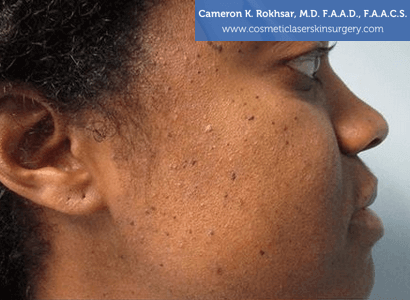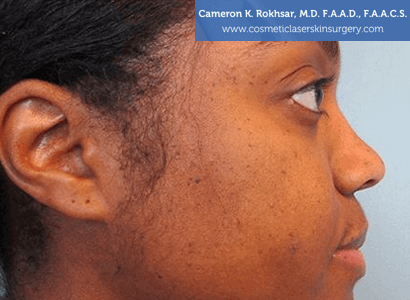Dermatosis Papulosa Nigra Removal in New York
Dermatosis Papulosa Nigra (DPN) is a series of benign, superficial papules on the neck and facial region, typically found on African Americans and Asians.
The appearance of multiple small, smooth brown or black bumps that are small in diameter typically arise on the face. It is a benign, or non-cancerous condition on the skin. It is asymptomatic, which means other symptoms do not accompany its presence. This is more of a cosmetically undesirable condition that doesn’t obstruct the view or leave patient with physical discomfort, leaving no other reason to remove the papules other than because the patient would like clearer skin, bereft of marks.
Dermatologists characterize severe cases by the appearance of 50 or more spots. The rate of occurrence, the number of bumps and size of bumps increase with age, however, Dermatosis Papulosa Nigra can occur in children as young as seven-years-old. There are more females affected by this condition than there are males. Family history can increase the likelihood for 40-50 percent of those diagnosed; otherwise, the cause of the skin condition is unknown. Those that have African-American heritages with fairer complexions have the lowest frequency of Dermatosis Papulosa Nigra, and although it can occur among Asians, the exact number of incidences is unknown.
Because they are non-life threatening, they require no surgical removal except for cosmetic purposes. If desired, patients can receive superficial treatment to remove spots:
- Curettage- remove by scraping
- Cryotherapy- the use of extreme cold to destroy tissue
- Electrocautery- the use of heat generated by the high-frequency current to destroy tissue
Dermatosis Papulosa Nigra Removal Before and After


* This patient underwent CO2 laser treatment for the DPNs (dermatosis papulosis nigra). These brown spots are genetic and are often found in patients with a genetic link to the Caribbean islands. This result is only after one session with this our state of the art CO2 laser.
Why Choose Dr. Rokhsar For Dermatosis Papulosa Nigra Treatment?
As a fellowship-trained cosmetic dermatologist, Dr. Rokhsar is an expert in treating Dermatosis Papulosa Nigra for individuals of any skin type.
Dermatosis Papulosa Nigra Removal FAQ
How to remove Dermatosis Papulosa Nigra (DPN)?
While there is no definitive cure for DPN, several treatment options are available for those seeking to remove the bumps. Here are some ways to remove DPN:
- Surgical Removal: Techniques such as curettage, scissor excision, shave excision, cryosurgery, electrodessication, dermabrasion, and laser removal can be used depending on the size and location of the bumps.
- Liquid Nitrogen: A dermatologist may use liquid nitrogen to freeze off the bumps.
- Electrodesiccation: A dermatologist can also use electrodesiccation to zap the bumps with an electric current from a probe. This is Dr. Rokhsar’s preferred method as it offers the safest and most effective procedure for painless removal of DPN. Dr. Rokhsar often combines light electrocautery, with our advanced pigment lasers, to safely and permanently remove DPNS on the face, neck, around the eyes and eyelids, chest, and back of patients of all skin colors or races including black, brown, hispanic, asian, indian and caribbean skin without scarring or pigmentary problems. A numbing cream is applied first for 30-60 mintees prior to the laser DPM removal procedure. Then, the DPN growths are individually treated with lasers or cautery one by one. Depending on the number of lesions treated, the procedure can take a few minutes to half an hour. In a single session, all DPN lesions can be treated and removed successfully regardless of if you have a few, hundreds or thousands of DPN growths on your face, neck or chest. Dr. Rokhsar is an expert in treating DPNs on dark skin without scarring or any color change.
While DPNs are not harmful, individuals should consult with a dermatologist before attempting to remove the bumps. Dr. Rokhsar can provide an accurate diagnosis and recommend the most appropriate treatment for each individual’s specific condition. It is also recommended to avoid applying makeup, including blush, to the treated area for three to four days after treatment to avoid any complications. The DPN treated areas should be kept moist with some vaseline for a few days for fast healing and kept away from the sun.
New York Office Locations
Upper East Side Manhattan Office
121 East 60th Street, Suite 8AB New York, NY 10022
(212) 285-1110
Long Island Office
901 Stewart Ave, Suite 240, Garden City, NY 11530
(516) 512-7616



 Dr. Rokhsar was chosen by
Dr. Rokhsar was chosen by 






